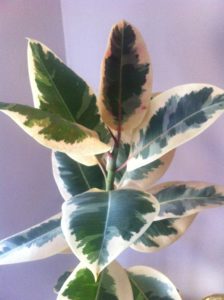Identification and Care of My Houseplant
Hi Judy,
Meet Murphy. He is a plant I recently inherited from my dear friend that just passed, he seems to need some TLC. It’s really important to me to keep him alive. I would really appreciate any help you can give me!
Hi Mj,
Murphy looks like a variegated Rubber Tree, but pictures can be deceiving sometimes. Just to be sure, could you tell me how large the leaves are and if they are thick or thin.

Here are some care tips for a Rubber Tree plant.
Light: Rubber Tree houseplants do best in medium to bright indirect light. The variegated varieties need more bright light.
Water: Rubber Tree houseplants are a little difficult to water. Always allow the top 25-30% of the soil of a Rubber Tree Plant to dry out before watering. Keep the soil even drier when your Rubber tree Plant is in lower light or the room temperature is cooler. The leaves of Rubber Tree housePlants turn yellow from under-water and over-water. Perfectly fine green, burgundy, or variegated leaves may fall off from over- water.
Fertilizer: Rubber Tree houseplants do not need much fertilizer. Feed a Rubber tree plant every other month when it is actively growing.
Temperature: Rubber Tree houseplants do well in warm temperatures between 70-80 degrees with a night time temperature around 65 degrees. Keep a Rubber Tree Plant away from cold drafts, air conditioners, heaters, and fireplaces.
Humidity: Basic household humidity is fine for Rubber Tree houseplants.
Pests: Whitefly, Scale, and Mealy Bugs are houseplant pest that can infest Rubber Tree houseplants.
Diseases: If plant diseases such as sooty mold appear spray all part of your Rubber Tree plant with the green solution diluted to 1/2 the usual strength.
Soil: Use a good well aerated houseplant soil that retains moisture but still drains well.
Pot Size:Rubber trees like to be root-bound in small pots.
Pruning: Cutting of the growing tip of a main stem encourages the plant to send out new shoots and become bushier. These plants are relatively pest free; but not dust free. It’s important to keep the dust off of the broad leaves, both for aesthetics and for the health of the plant. Two commercial products I find helpful are Pokon and Foliglo. Never use milk or mayonnaise to clean the leaves of your houseplants.; this attracts bugs and clogs the pores in the leaves.
Propagation: Stem cuttings and air layering are the best ways to propagate a Rubber plant.
These plants are considered poisonous and should be kept away from pets and children. Read more about common houseplants that are poisonous in Don’t Feed Me To Your Cat! A Guide to Poisonous.
